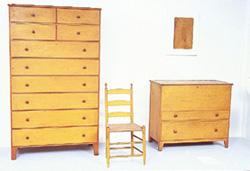History
Shaker style furniture has its roots in some very specific religious beliefs. The United Society of Believers in Christ’s Second Coming (frequently called the Shakers because of their wild movement during worship services) got their start in France in the 17th century, but fled to England in 1706. By 1774, a group of eight Shakers had immigrated to the United States, where they began working to create a “utopian” society. The Shakers prided themselves on their humbleness, hard work, and efficiency, and Shaker style furniture reflects these values. Shaker furniture is completely devoid of any decoration; in fact, the Shakers believed that decorative elements were offensive to God.
Wood
The Shakers traditionally produced furniture from oak, cherry, and walnut, but also relied heavily on local hardwoods for their furniture making.
Characteristics
Shaker furniture was designed with clean, geometric lines. Pulls were typically made from the same wood as the rest of the piece. Shaker pieces are notoriously sturdy and well built. Dovetailed and mortise-and-tenon joints were common. Because wastefulness was considered sinful, the Shakers produced lightweight furniture, using as little wood as possible while still creating a functional piece.
To prevent chairs from cluttering their living spaces, Shakers often built and installed chair pegs on their walls. This allowed the chairs to hang, out of the way, until they were needed again.
Shaker style bedroom furniture was equally Spartan. Built-in cupboards and drawers were common in Shaker houses. Bedposts were short- again, to avoid wasting precious wood.
Embellishments
The only element of Shaker furniture that might be construed as “decorative” is the use of paint to preserve and protect the wood. Each piece was painted a single, solid color. White, red, and yellow were the most common colors, and these paints were created from minerals found nearby. Other pieces were finished with a simple coating of oil.
What to Look For
Because Shakers tried to be as self-sufficient as possible, virtually all of their home furnishings were handmade. Storage baskets, tables, benches, and chairs are the most common items available today. Although only one working Shaker community exists in the United States today, replicas of this popular style are produced throughout the United States and Europe. In fact, some historians consider Shaker furniture the inspiration for modern Scandinavian style. If you can’t find what you’re looking for at the antique shop, check out one of the many reproduction retailers.
Price
Because antique Shaker furniture is in high demand and wasn’t produced in great quantities, genuine antiques are rare and expensive. A single dining room chair might cost anywhere from $500 o $1,000, depending on condition. Dressers can command $45,000. And a blanket chest might cost $15,000- $20,000.
For a less pricey alternative, consider purchasing reproductions of larger pieces (they’ll cost approximately the same as any good-quality modern furniture) and tie the room together with authentic accent pieces- hatboxes, baskets, and chair pegs can cost as little as $50 each.
A final option is to try your hand at creating these pieces yourself. Although the Shakers were master furniture makers, the simple lines and basic construction techniques of Shaker style furniture are good starting points for even novice woodworkers.
Shaker Furniture Photo courtesy the Shaker Museum and Library

